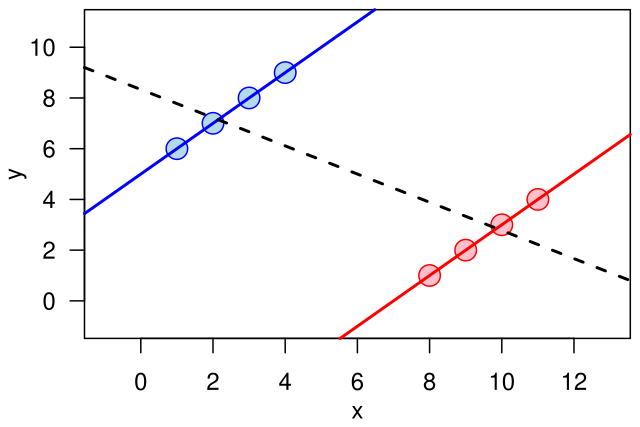Dear all, I performed a differential gene expression analysis with the DESeq2 package and corrected for hidden variation with the sva package. Now I found genes, which have a negative LFC value in response to a given treatment, although they have higher (normalized) counts in these treatment samples than in the control samples. These genes are not significantly expressed in this treatment, but they show a significant interaction between two factors and I was wondering whether I can trust the interaction term, when the sign of the ES might be wrong/biased? When I check the expression of this gene in the data set which is not corrected with sva, then the LFC in the single factor treatment is positive (still not significant), as I would expect based on the counts. I thought that the covariates will correct for data variation that is not related to the treatment but I did not expect that this might result in a change of the effect size sign?
Any thoughts on that are very much appreciated :)!
Here are the relevant code snippets
##create DESeq object
dds1 <- DESeqDataSetFromTximport(txi.sum, sampleData, design= ~ Salt*Sediment*Flow)
dds1 <- DESeq(dds1)
##estimate SVs
dat <- counts(dds1, normalized = TRUE)
mod <- model.matrix(~ Salt*Sediment*Flow, colData(dds1)) ##full model
mod0 <- model.matrix(~ 1, colData(dds1))
svseq <- svaseq(dat, mod, mod0) #this estimated 10 SVs
#include SVs
ddssva <- dds1
ddssva$SV1 <- svseq$sv[,1]
ddssva$SV2 <- svseq$sv[,2]
ddssva$SV3 <- svseq$sv[,3]
ddssva$SV4 <- svseq$sv[,4]
ddssva$SV5 <- svseq$sv[,5]
ddssva$SV6 <- svseq$sv[,6]
ddssva$SV7 <- svseq$sv[,7]
ddssva$SV8 <- svseq$sv[,8]
ddssva$SV9 <- svseq$sv[,9]
ddssva$SV10 <- svseq$sv[,10]
design(ddssva) <- ~ SV1+SV2+SV3+SV4+SV5+SV6+SV7+SV8+SV9+SV10+Salt*Sediment*Flow
ddssva <- DESeq(ddssva)
##genes which show a different expression due to the interaction of sediment and flow
sed_flow_inter <- results(ddssva, contrast = list(c("Sedimentadded.Flowreduced")), alpha = sig_lvl)
##extract results for the single treatment
flow <- results(ddssva, contrast=c("Flow.Velocity", "reduced", "normal"), alpha = sig_lvl)
sessionInfo( )
R version 4.1.1 (2021-08-10)
Platform: x86_64-w64-mingw32/x64 (64-bit)
Running under: Windows 10 x64 (build 19044)
Matrix products: default
locale:
[1] LC_COLLATE=German_Germany.1252 LC_CTYPE=German_Germany.1252
[3] LC_MONETARY=German_Germany.1252 LC_NUMERIC=C
[5] LC_TIME=German_Germany.1252
attached base packages:
[1] parallel stats4 stats graphics grDevices utils
[7] datasets methods base
other attached packages:
[1] DEGreport_1.28.0 ashr_2.2-54
[3] apeglm_1.14.0 PCAtools_2.4.0
[5] ggrepel_0.9.1 ggplot2_3.3.6
[7] sva_3.40.0 BiocParallel_1.26.2
[9] genefilter_1.74.1 mgcv_1.8-36
[11] nlme_3.1-152 DESeq2_1.32.0
[13] SummarizedExperiment_1.22.0 Biobase_2.52.0
[15] MatrixGenerics_1.4.3 matrixStats_0.62.0
[17] GenomicRanges_1.44.0 GenomeInfoDb_1.28.4
[19] IRanges_2.26.0 S4Vectors_0.30.2
[21] BiocGenerics_0.38.0 tximport_1.20.0
loaded via a namespace (and not attached):
[1] colorspace_2.0-3 rjson_0.2.21
[3] ellipsis_0.3.2 circlize_0.4.15
[5] XVector_0.32.0 ggdendro_0.1.23
[7] GlobalOptions_0.1.2 clue_0.3-61
[9] rstudioapi_0.13 bit64_4.0.5
[11] AnnotationDbi_1.54.1 fansi_1.0.3
[13] mvtnorm_1.1-3 codetools_0.2-18
[15] splines_4.1.1 sparseMatrixStats_1.4.2
[17] logging_0.10-108 mnormt_2.1.0
[19] doParallel_1.0.17 cachem_1.0.6
[21] knitr_1.39 geneplotter_1.70.0
[23] Nozzle.R1_1.1-1.1 broom_1.0.0
[25] annotate_1.70.0 cluster_2.1.2
[27] png_0.1-7 compiler_4.1.1
[29] httr_1.4.3 backports_1.4.1
[31] dqrng_0.3.0 assertthat_0.2.1
[33] Matrix_1.3-4 fastmap_1.1.0
[35] limma_3.48.3 cli_3.3.0
[37] BiocSingular_1.8.1 lasso2_1.2-22
[39] tools_4.1.1 rsvd_1.0.5
[41] coda_0.19-4 gtable_0.3.0
[43] glue_1.6.2 GenomeInfoDbData_1.2.6
[45] reshape2_1.4.4 dplyr_1.0.9
[47] Rcpp_1.0.9 bbmle_1.0.25
[49] vctrs_0.4.1 Biostrings_2.60.2
[51] iterators_1.0.14 DelayedMatrixStats_1.14.3
[53] psych_2.2.5 xfun_0.31
[55] stringr_1.4.0 beachmat_2.8.1
[57] lifecycle_1.0.1 irlba_2.3.5
[59] XML_3.99-0.10 edgeR_3.34.1
[61] zlibbioc_1.38.0 MASS_7.3-54
[63] scales_1.2.0 RColorBrewer_1.1-3
[65] ComplexHeatmap_2.11.1 memoise_2.0.1
[67] emdbook_1.3.12 bdsmatrix_1.3-6
[69] reshape_0.8.9 stringi_1.7.6
[71] RSQLite_2.2.14 SQUAREM_2021.1
[73] foreach_1.5.2 ScaledMatrix_1.0.0
[75] shape_1.4.6 truncnorm_1.0-8
[77] rlang_1.0.4 pkgconfig_2.0.3
[79] bitops_1.0-7 lattice_0.20-44
[81] invgamma_1.1 purrr_0.3.4
[83] cowplot_1.1.1 bit_4.0.4
[85] tidyselect_1.1.2 plyr_1.8.7
[87] magrittr_2.0.3 R6_2.5.1
[89] generics_0.1.3 DelayedArray_0.18.0
[91] DBI_1.1.3 pillar_1.7.0
[93] withr_2.5.0 survival_3.2-11
[95] KEGGREST_1.32.0 RCurl_1.98-1.7
[97] mixsqp_0.3-43 tibble_3.1.7
[99] crayon_1.5.1 utf8_1.2.2
[101] GetoptLong_1.0.5 locfit_1.5-9.6
[103] grid_4.1.1 blob_1.2.3
[105] ConsensusClusterPlus_1.56.0 digest_0.6.29
[107] xtable_1.8-4 tidyr_1.2.0
[109] numDeriv_2016.8-1.1 munsell_0.5.0



Thanks a lot!